Looking forward to REF 2029
REF 2029 is expected to introduce significant alterations – particularly around the decoupling of researchers and outputs. This shift in emphasis will necessitate a review and retooling of some of the functionality within Symplectic Elements to continue to effectively support the new REF process. We are working closely with our client community and the funding bodies to ensure that Elements continues to be the platform of choice for the REF.
“Symplectic’s OA Monitor was pretty critical to our REF open access compliance monitoring – I can’t really imagine doing without it.”
Alan Bracey, Open Access Compliance Manager, University College London
Background: What is the REF?
The Research Excellence Framework (REF) is a UK-wide assessment of the quality of research in universities, undertaken on behalf of the UK Government by the four higher education funding bodies (Research England, the Scottish Funding Council, the Higher Education Funding Council for Wales, and the Department for the Economy, Northern Ireland).
For Higher Education Institutions (HEIs), the REF is not only a part of securing funding and demonstrating societal impact, but also a key contributor to an institution’s reputational ability to attract a high calibre of talent and knowledge across faculty, students and researchers (thereby creating a ‘virtuous circle’, wherein high quality researchers lead to high quality research and vice-versa).
The REF was first carried out in 2014, replacing the previous Research Assessment Exercise, with processes once again revised considerably ahead of the REF2021 following the recommendations of the 2016 independent review of the REF led by Lord Stern.
As part of his review, Stern noted that “Research information systems (RIS) play an increasingly important role for the governance of research at the institutional, funding body and national levels”.
Symplectic and the REF

Symplectic’s support for the REF has grown from strength to strength following our early support of the Research Assessment Exercise (RAE), which was replaced in 2014 by the REF as we know it today. As the framework has evolved and grown, so too has our approach to it. Following each revision by the funding bodies, we work closely with the Symplectic community to identify requirements and outline new functionality that will enable our institutional clients to meet and respond to the requirements of the REF as painlessly and productively as possible.
“There is no single way for a vendor to prescribe functionality to the research community, so it’s far better to be consultative and work together in partnership,” says Jonathan Breeze, CEO at Symplectic. “Over time, working through REF2014 and then REF2021, we developed the trust from clients that we could work with them effectively to solve the challenges set by the funding bodies.”
Sign up below to learn more about how Symplectic supports the REF
“In 2021, we submitted just over 700 FTEs in 17 Units of Assessment, 1678 outputs and 67 impact case studies. If we tried to do that using the old method I dread to think what would have happened, so Elements was really invaluable in getting
our REF submission in.”
Phineas Wenlock, Research Systems Manager, University of Essex
How Symplectic clients approached REF2021
There’s no one-size-fits-all when it comes to the REF, and different institutions take a different approach to gathering and collating information for submission. Symplectic Elements can help you to collate, curate, validate and process your data for the REF in a number of different ways.
 |
In this whitepaper, find out:
|
“We know how important the REF is to our UK institutions, so we created a dedicated team to focus time and resources throughout the 18 months leading up to REF2021,” says Manya Buchan. “Workflows and functionality were designed to align both with internal institutional processes, and with the complexity inherent in the REF submission process.”










